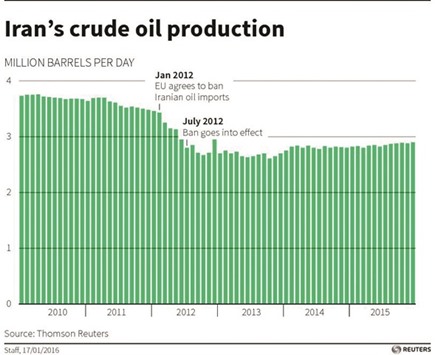Iran still faces constraints on oil exports as buyers are cautious about boosting trade immediately because of banking and ship insurance difficulties, a senior Iranian oil official said, despite seeing a “tangible” rise in shipments last month.
Iran emerged from years of economic isolation in January when world powers led by the US and the European Union lifted crippling sanctions against Opec’s No 3 oil producer in return for curbs on Tehran’s nuclear ambitions.
The sanctions had cut Iranian crude exports from a peak of 2.5mn bpd before 2011 to just over 1mn bpd in recent years.
Iran is working to regain market share after sanctions relief and exports had already risen by 500,000 bpd in February, Mohsen Ghamsari, director of international affairs at National Iranian Oil Co (NIOC), told Reuters on Tuesday.
But the country’s crude shipments, particularly to Europe, have been complicated by a lack of clarity on ship insurance, dollar clearance and European banks’ letters of credit.
“For March, definitely our volumes are going to be higher than February ... but it depends on the logistics situation and the banking channels. Still, some shipping companies are somehow reluctant to come and banks also,” he said in a telephone interview from Tehran.
“If everything goes well, definitely the volumes for March are going to be higher than February. The difference between March and February is going to be quite tangible. The main or biggest portion of these additional cargoes is going to be destined for Europe,” he added.
Litasco, the trading arm of Russia’s Lukoil, Spanish refiner Cepsa and France’s Total have become the first buyers in Europe since the lifting of sanctions, trading sources told Reuters.
Ghamsari said those cargoes were trial shipments and NIOC had started negotiations for term contracts with potential buyers.
“Definitely in March you are going to see some good news for additional barrels or cargoes destined to Europe,” he said.
Tehran has said it would boost output immediately by 500,000 bpd and by another 500,000 bpd within a year, ultimately reaching pre-sanction production levels of around 4mn bpd seen in 2010-2011.
Ghamsari said it was difficult to give an exact number for Iran’s oil exports but the plan was to raise shipments by roughly an additional 500,000 bpd to reach 2mn bpd this year, depending on market conditions.
“We believe within this year we have to maximise our share ... our goal is to have it within this year,” he said.
“But it is a plan and it is a desire. How much it is successful depends on the market and the negotiations with the customers,” he said.
Even a gradual increase in Iran’s exports would come at a time of global oversupply, with producers around the world pumping hundreds of thousands of barrels every day in excess of demand.

..
